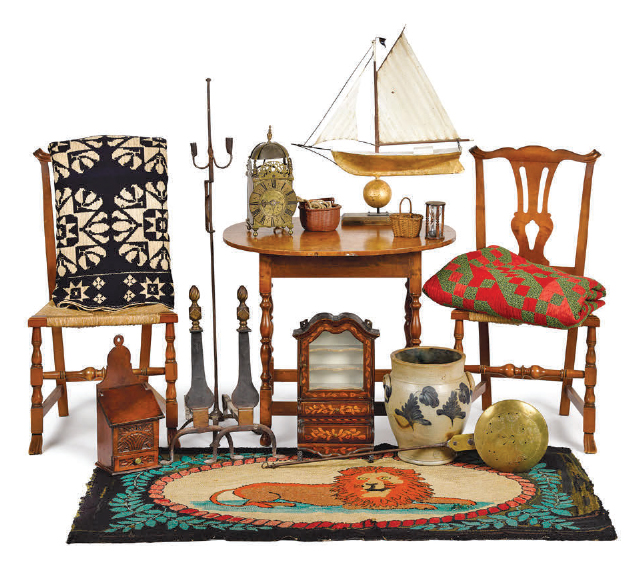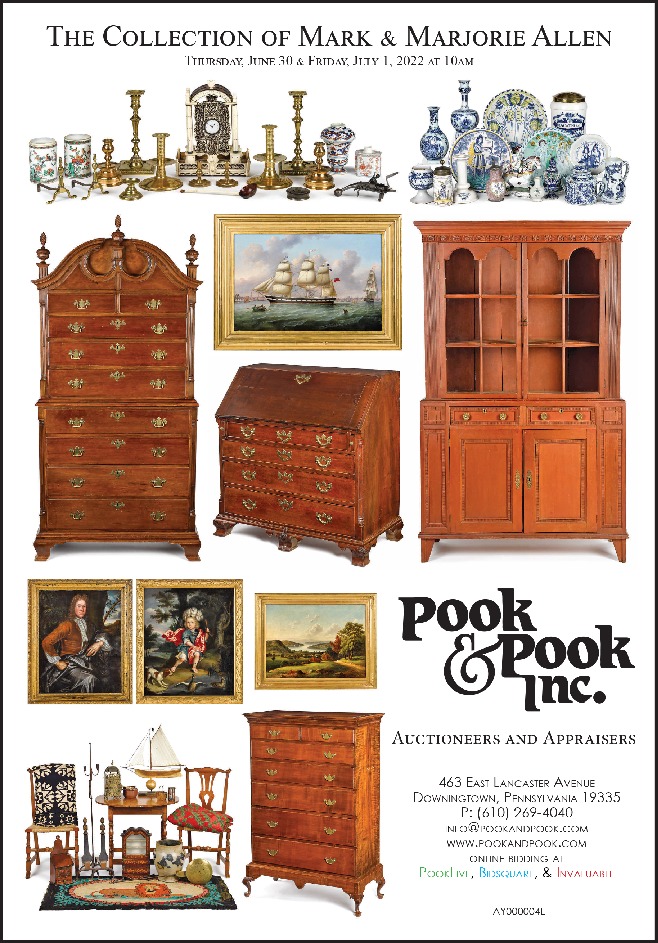Events
Home / Events

Pook & Pook – The Collection of Mark & Marjorie Allen
Thu Jun 30, 2022 - Fri Jul 01, 2022
463 East Lancaster Avenue - Downingtown, PA 19335
Pook & Pook – The Collection of Mark & Marjorie Allen
Thursday, June 30 & Friday, July 1, 2022 at 10am
463 East Lancaster Avenue Downingtown, PA 19335
www.PookandPook.com
info@PookanDPook.com
610-269-4040
DOWNINGTOWN, PENN. — On June 30 and July 1, Pook & Pook will present the collection of Mark and Marjorie Allen of New Hampshire. Well-known for English and Dutch delftware of the Seventeenth and Eighteenth Centuries, the Allens had a large and comprehensive delftware inventory. Their focus was early, collecting brass of the Seventeenth and Eighteenth Centuries, pre-Federal American and country furniture, paintings and export porcelain. Like Seventeenth Century merchants, they provided their modern customers imported delftware and brass like that desired by early colonial households. The diversity of goods available is reflected in the 625 lots of furniture, landscape and portrait paintings, delftware, brass and other decorative arts to be sold over two days.
The sale opens with one of Mark Allen’s personal favorites, a Chippendale walnut slant front desk, circa 1760, attributed to the workshop of Thomas White, Perquimans County, N.C. Pictured in American Furniture by John Bivins, edited by Luke Beckerdite, with provenance M. DuPont, it will be a main attraction. Overall, the Allen furniture encompasses at least eight of the colonies and Canada, featuring many New England William and Mary, Queen Anne, Chippendale and country examples. Of particular note is the wide assortment of Eighteenth Century tavern tables. There are Queen Anne and Windsor chairs to choose from, and a variety of hanging shelves and cupboards, wall cupboards and a Pennsylvania walnut pewter cupboard.
Tables include three New England examples: a delicate William and Mary gateleg table, circa 1740, a William and Mary flame birch gateleg table and a cherry butterfly table. Other tables include a slight Delaware Valley Queen Anne walnut dressing table, circa 1760, with squared cabriole legs and unusual brushed Spanish feet. William and Mary furniture includes a large walnut gateleg dining table, circa 1740, also with brushed Spanish feet, and a large Hudson Valley William and Mary mahogany and gumwood gateleg table, circa 1740. Case pieces include four from New England: a Queen Anne cherry chest on chest, circa 1765, a Queen Anne cherry high chest, a Chippendale maple chest of drawers with elaborate scalloped apron and feet and a Chippendale mahogany serpentine chest of drawers.
From the other colonies are a New Hampshire Queen Anne tiger maple chest on frame, circa 1765, a Rhode Island Chippendale cherry chest on chest and a Connecticut Chippendale cherry serpentine chest of drawers.
Painted furniture includes a New England pine barrel-back corner cupboard, a Maine Sheraton chest of drawers, circa 1815, retaining a swirl decorated surface with yellow and green striping. Another highlight is a finely detailed Bergen County, N.J., painted cupboard, circa 1810, retaining an old red surface. Chests include a Massachusetts joined oak blanket chest, late Seventeenth Century, a China Trade camphorwood chest and New England and Pennsylvania miniature blanket chests.
More than 50 lots of candlesticks include many English Queen Anne brass, English bell metal, English brass six shell, English Georgian, Dutch Heemskirk, Spanish brass and a pair of engraved brass Huguenot candlesticks. Other brass includes German alms dishes. An entertaining assortment of zoomorphic food choppers take the forms of diverse creatures.
Delftware steals the show, with a rare Dutch Delft five-piece garniture set, mid-Eighteenth Century, decorated in the Imari palette. An early Dutch majolica blue dash small charger, circa 1625, depicts an urn of tulips, while a Dutch Delft Adam and Eve charger is from later in the century. Other Seventeenth Century wares include chargers and plates possibly from the Pickelherring Factory. A polychrome Delft vase, circa 1700, is initialed by Adrin Pynacher, and a circa 1700 plaque is marked by Jacobus Pljnocker. Dutch blue and white Delft tobacco jars stand alongside polychrome jars, a pair of which is initialed BP for the De Blompot workshop. Urns, apothecary jars, posset pots and pitchers form a colorful display of polychrome, blue and white and chinoiserie. Dutch blue and white Delft plates and chargers from the Eighteenth Century are decorated with harbor scenes, chinoiserie and couples strolling in the countryside. On a large plaque a couple sits amorously by a fire, initialed VDK, probably for Jan van der Kloto. Dutch Delft dore includes a teapot in the Imari palette, and a rare Dutch Delft dore sauce boat and undertray, circa 1730, is signed by Zacharias Dextra. A Dutch polychrome Delft horse and rider, made at the De Roos factory, has a fine form. English Delft includes blue dash Adam & Eve chargers, late Seventeenth Century; a London Delft blue dash tulip charger, late Seventeenth Century; a Bristol Delft King George portrait charger; and a blue and white William and Mary portrait plate.
Several paintings include an attributed to Duncan McFarlane (British/America, 1834-1871) oil on canvas of the British ship Birkby off the Liverpool harbor; an oil on canvas of the well-known Connecticut River Oxbow, as seen from Mount Holyoke, attributed to Victor De Grailly (American, 1804-1889); and attributed to Robert Dellow (circa 1696-1736), a portrait of the young Sir Thomas Pope Blount, 2nd Baronet (1670-1731), in a lush landscape with a small dog and ducks.
The collection of Mark and Marjorie Allen will be exhibited for preview beginning on Saturday, June 25, at 9 am.
Pook & Pook is at 463 East Lancaster Avenue. For information, www.pookandpook.com or 610-269-4040.

Antiques and The Arts Weekly is the nation’s leading weekly publication on the antiques and the arts trade, and is available both in print and online.
Each issue average between 100-200 pages and includes reporting on auctions, antiques shows and the arts while providing a platform for both buying and selling.
We have been providing breaking news and important information on the world of antiques and the arts since Publisher R. Scudder Smith started Antiques and The Arts Weekly back in 1963.
Contact
LOCATED AT:
5 Church Hill Road / Newtown, CT 06470
HOURS:
Mon - Fri / 8:00 am - 5:01 pm
PHONE:
(203) 426-8036

